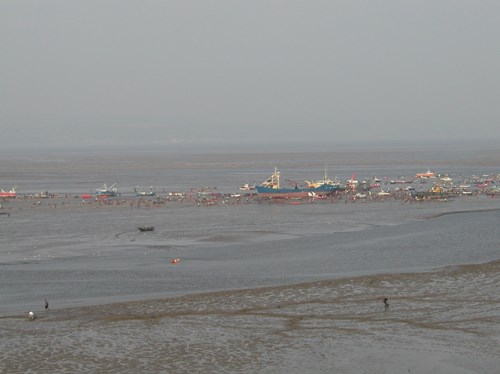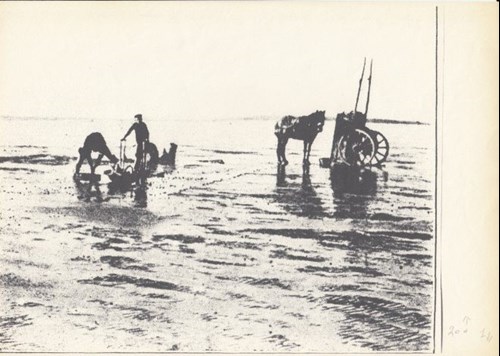The Unsung Cockle Heroes
Timothy Ellis, Dee Estuary Officer reveals how we’ve come full circle to bring about this success story of sustainability…
In the ‘old days’, the wild species C. edule (common cockle to most of us) would occasionally settle on the beaches of the Dee Estuary, on the border between England and north Wales. Hundreds of fishermen would come from far and wide to bring in a harvest.

Cockling frenzy of the past!
At best, they’d get about three days of harvesting and the beaches would be left bare of shellfish for the next few years.
But, in the really old days, the estuary’s local fishermen would carefully rake in the larger cockles over the summer and autumn months, leaving behind a healthy breeding stock whilst taking care to protect the fishing grounds.
Cockles would be hand-raked into a large sieve. This method leaves behind the smaller cockles to grow on in subsequent years. The hand-raking method is also considered the least damaging to the environment, creating the least impact or disturbance.

Flookburgh fishermen off Grange, fishing for cockles. Credit: Keith Willacy collection
Since 2008, NRW (and previously EAW) has regulated the cockle fishery in the Dee (Fishery Regulation). This year will be the 12th consecutive year that we’ll open the fishery. In this case, regulation means limiting the number of fishermen licenced to harvest and limiting the fishery quota to sustainable levels. All signs suggest it’s working. We’ve returned the fishery to its more sustainable roots.
Investigating and analysing….
Naturally, this isn’t just luck. We use evidence-based methodologies to calculate the fishery stock year-on-year, and we manage the fishery as a sustainable resource.
Each spring and autumn, teams of our scientists carry out stock-surveys over the whole of the 15,000-hectare estuary. After walk-over surveys to determine where the cockles live each year, our surveyors use quantitative sampling techniques to calculate the cockle-stock available.
The method of sampling is very similar to that used for generations by the fishermen on the estuary. A quadrat is used to determine the area from which to collect the cockle samples. Any shellfish found are sorted or riddled through a series of calibrated sieves to determine size-class cohorts. The cockles are counted and the results are recorded in the field. A sub sample is then brought to shore for further measurements.
For the last two years, I’ve joined the survey team, learning the trade and trying to keep up whilst slogging through knee-deep mud! It’s a good workout.
After learning all about the joys of wading through the slop on the softer mud-banks last year, I had my fingers firmly crossed that I wouldn’t get one of the tougher areas this time around. Interestingly, I had absolutely no feelings of guilt when I was handed a map for a known easy-bit!
So what do we do with the data?
As a highly protected part of our natural environment, we have a duty to ensure that we manage activities within the estuary.
This, in part, includes making sure there’s enough food for protected over-wintering birds such as oyster catcher and knott. As it happens, cockles are the favourite food of oyster catchers.
We use growth models to calculate the amount of cockle that will be available to the birds to eat over the winter. After leaving sufficient behind for the birds, accounting for the need to protect next year’s breeding stock and through understanding the needs of our local fishermen, we can develop a pattern of harvesting that is sustainable.
There is of course Mother Nature to contend with and she tends to throw up all sorts of unexpected challenges that can make a mockery of our finest models and plans. That’s where our field-scientists and data experts come back into play with the autumn surveys. Happily, the last 11 years of data suggest we seem to be getting it right. Once the numbers are in, we can open the fishery for commercial harvesting that forms such an important part of our local culture and heritage on the estuary.
Partnership working
Managing and regulating the fishery relies on the input of many dedicated people, both internal and external to NRW. Although coordination for most of the work needed to support the fishery appears to come from the Dee Cockle Fishery’s Management Team, without the contribution from the fishermen, ecologists, field scientists, enforcement teams, legal teams, technical specialists, and policy advisers (to name only a few), the fishery could not operate sustainably.
As a case-study for collaborative working, the Dee Estuary cockle fishery stands out as a strong example of successful partnership working to deliver the sustainable management of natural resources.
None of us work in isolation, and it’s our colleagues at the sharp-end who are the real unsung heroes of the cockle fishery on the Dee.
